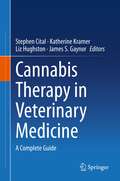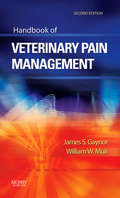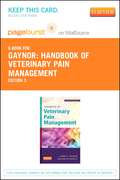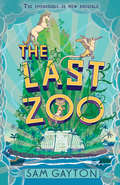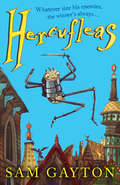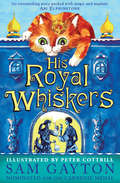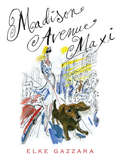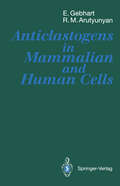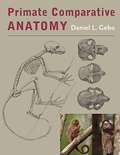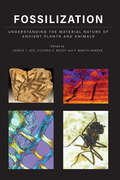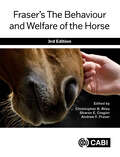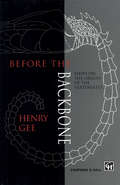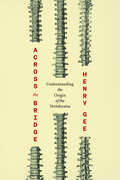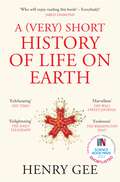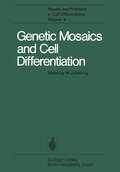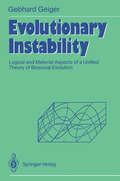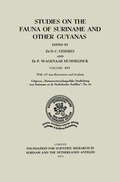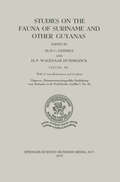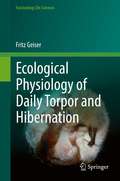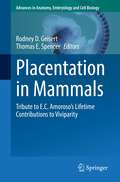- Table View
- List View
Cannabis Therapy in Veterinary Medicine: A Complete Guide
by James S. Gaynor Stephen Cital Katherine Kramer Liz HughstonThis book provides in-depth information on the applications of cannabis products as a legitimate medicine in treating a variety of diseases and disorders in domestic animals. Pharmacology and toxicology of cannabinoids and their effects on the endocannabinoid system, which is involved in the regulation of diverse physiological and cognitive processes, are discussed in detail. Furthermore, the book reviews development and testing of cannabis based medical products and introduces the nutritional components of cannabis plants. Cannabis as a therapeutic in veterinary medicine is gaining interest among owners and practitioners. Numerous studies have been completed or are currently underway that analyze the potential of clinical application of cannabinoid and terpenoid molecules. In this book the authors take a comprehensive look at previous studies in animal and human models and discuss translational applications based on these scientific data. This seminal text serves as a go-to resource for veterinary practitioners on cannabinoid therapy. It will also serve as a foundation for clinicians and researchers interested in this emerging field of veterinary medicine.
Handbook of Veterinary Pain Management - E-Book
by James S. Gaynor William W. Muir IIIYou can trust this user-friendly guide to help you meet the increasing need for effective pain management in the animals you treat. It provides instant access to clinically relevant information on pain assessment, pharmaceutical and non-pharmaceutical treatment options, guidelines for managing acute and chronic pain, and unique aspects of pain management in dogs, cats, horses, cattle, birds, reptiles, ferrets, and rabbits.User-friendly format helps you quickly and easily find essential pain management information.Helpful boxes and tables provide at-a-glance access to pharmacologic protocols and clinical applications, including dosages, indications, contraindications, and side effects.Complementary and alternative treatment strategies are included throughout to assist you in using the latest non-pharmacological pain interventions.Case studies clearly illustrate the practical applications of key concepts in the clinical setting and help you sharpen your pain assessment and management skills.New contributors — many of the most respected experts in the field — share their insights and experiences to bring you the most current thinking in this ever-changing discipline.Completely revised and updated content throughout ensures you are using the best and most current information available on analgesic drugs and pain management techniques.An expanded chapter on Pain Management in Horses and Cattle explores the latest advances in treating this group of animals.Eight new chapters offer cutting-edge coverage of hot topics in the field, including:Pain Management in the CatPain Management for the Pet BirdClinical Approaches to Analgesia in ReptilesClinical Approaches to Analgesia in Ferrets and RabbitsPhysical Therapy and Rehabilitation in DogsRehabilitation Methods and Modalities for the CatQuality of Life IssuesHospice and Palliative Care
Handbook of Veterinary Pain Management - E-Book
by James S. Gaynor William W. Muir IIITrust the Handbook of Veterinary Pain Management, 3rd Edition to help you meet the increasing need for effective pain management in the animals you treat. This user-friendly guide contains the most up-to-date and clinically relevant information on analgesic drugs and managing pain in dogs, cats, birds, reptiles, ferrets, and rabbits. It specifically covers the areas of pain assessment, pharmaceutical and non-pharmaceutical treatment options, guidelines for managing acute and chronic pain, and unique aspects of pain management. This edition also incorporates expanded information on cats, exotics, the latest drugs, and more to keep you on top of today’s best practices in veterinary pain management.The latest information on complementary and alternative strategies for pain management offers the guidance to help you incorporate non-pharmacologic treatments into their pain management programs.Numerous boxes and tables summarize pharmacologic protocols and clinical applications, with dosages, indications, contraindications, and side effects to provide you with the comprehensive drug information needed to find the most effective and appropriate treatment.User-friendly format helps you quickly and easily find essential information.Case studies illustrating realistic clinical scenarios help you learn how to assess and manage pain in the clinical setting.NEW! Eight new chapters include the latest information on: the human-animal bondlocal and regional techniquespreventive and multimodal analgesiaenergy modalitiesacupuncturephysical examination with emphasis on isolating and locating paintherapeutic goalspain in laboratory animals NEW! Completely updated drug information, with new agents, doseforms, and routes provides the most current pain management therapies for use in the clinical setting.NEW! Expanded sections on the cat and exotics address the growing popularity of these pets by providing additional species-specific information.
The Last Zoo
by Sam GaytonPia lives in a zoo in the middle of the Pacific Ocean with her parents (both ghosts), several old and cranky genies, a devil, and two young angels. She spends her days trimming genie-beards, trying to avoid being tricked into selling her soul, and waiting for the angels to make a miracle big enough to save the world.Then the angels go missing. Can she solve the riddles of the mysterious haloes the angels have left behind? Is the zoo’s devil really trying to help her? And what does this all have to do with her best friends, the Rekkers? Pia needs to solve the mystery fast, because everything around her seems to be ending: her friendships, her childhood, and maybe even the world itself.
Hercufleas
by Sam Gayton Peter CottrillGreta is a girl on a mission: to venture to Avalon and bring back a hero who can save her home from destruction by the monstrous giant Yuk. Many heroes have tried before now. Many have failed. What Greta needs is a hero whose courage and self-belief are greater than himself. She needs Hercufleas. The only problem: he is a flea, no bigger than a raisin. But the smallest person might just have the biggest effect . . .
His Royal Whiskers
by Sam Gayton Peter CottrillSomething bad has happened to Prince Alexander, the only heir to the mighty Petrossian Empire.Something worse than kidnapping.Something worse than murder.Somehow, the Prince has been miraculously transformed into a fluffy-wuffy kitten.Why has this terrible catastrophe happened?Who are the boy and girl brewing secret potions down in the palace kitchens?And how are they possibly going to avoid getting their heads chopped off?
Madison Avenue Maxi
by Elke GazzaraWhen Ben Gazzara and his wife, Elke, reluctantly agree to adopt the pet dachshund their daughter no longer wants, the couple unknowingly takes a new member into their family. Neither of the Gazzaras is a "dog person," and the sudden presence of a pet in the lives of these jet-setters appears at first uncertain. However, the ever-sweet, playful, and surprisingly smart Maxi immediately endears herself, and soon she becomes the Gazzaras' unlikely "child" in the empty nest of their Madison Avenue townhouse. The little dog accompanies the pair everywhere - to the theater, restaurants, dinner parties, world-class hotels, receptions for heads of state, and even the dentist. Madison Avenue Maxi is the story of a love affair between a dog and her owners. With heartfelt humor and a dog lover's eye, Gazzara chornicles Maxi's antics in Manhattan as well as at their second home in Tuscany and over travels to the French Riviera, Brazil, Spain, and other luxurious locales. Along the way she meets celebrities such as Roman Polanski, Gena Rowlands, John Voigt, Danielle Steele, Gay Talese, Peter Bogdanovich, New York's mayor Michael Bloomberg, and Frank Gehry. Madison Avenue Maxi is a warm, touching memoir of man - and woman's-best friend.
Anticlastogens in Mammalian and Human Cells
by Erich Gebhart Ruben M. ArutyunyanAnticlastogens in Mammalian and Human Cells covers research on the protection of chromosomes from the action of chemical mutagens by use of natural and synthetic antimutagens, which, because of their specific action on clastogenic damage are called anticlastogens. Based on an introductory chapter on nature and mode of formation of chromosome aberrations induced by chemical and also physical mutagens, the action of anticlastogens is discussed in detail. A definition and delineation of the term anticlastogenesis is followed by considerations on the various possibilities of classifying anticlastogens. Attention is paid to the action of anticlastogens in mammalian and human cell culture systems, in vivo data on anticlastogens are presented in great detail, as are the actions of anticlastogens on induced sister chromatid exchanges in various test systems. A mainly historical side-glance at the action of anticlastogens on chromosome damage induced by ionizing radiation is taken. The practical consequences of the findings on anticlastogenic action are extensively discussed as aspects of further research.
Primate Comparative Anatomy (PDF)
by Daniel L. GeboWhy do orangutan arms closely resemble human arms? What is the advantage to primates of having long limbs? Why do primates have forward-facing eyes? Answers to questions such as these are usually revealed by comparative studies of primate anatomy. In this heavily illustrated, up-to-date textbook, primate anatomist Daniel L. Gebo provides straightforward explanations of primate anatomy that move logically through the body plan and across species. Including only what is essential in relation to soft tissues, the book relies primarily on bony structures to explain the functions and diversity of anatomy among living primates. Ideal for college and graduate courses, Gebo's book will also appeal to researchers in the fields of mammalogy, primatology, anthropology, and paleontology. Included in this book are discussions of: * Phylogeny* Adaptation* Body size* The wet- and dry-nosed primates* Bone biology* Musculoskeletal mechanics* Strepsirhine and haplorhine heads* Primate teeth and diets* Necks, backs, and tails* The pelvis and reproduction* Locomotion* Forelimbs and hindlimbs* Hands and feet* Grasping toes
Fossilization: Understanding the Material Nature of Ancient Plants and Animals
by Carole T. Gee Victoria E. McCoy P. Martin SanderUnderstanding the complex interplay of physical and chemical processes leading to fossilization is crucial to elucidating the 3800 million years of life on earth. And yet, the process of fossilization also leads to the loss of pivotal biological information, placing constraints on the very same understanding of ancient life it preserves. Over the last decade, however, remarkable advances in approaches, techniques, tools, and instrumentation have helped scientists to transcend these constraints by enabling high-resolution analysis of fossil material—even down to the nanoscale. Fossilization provides a critical look at these cutting-edge innovations in the science of fossil preservation and provides a road map for future research. Drawing from the fields of paleontology, organic and inorganic chemistry, microbiology, and high-resolution imaging and analysis, and spanning the diversity of life from plants to vertebrates and invertebrates, this resource details expert findings on• fossilization of hard and soft part tissues in dinosaurs• high-resolution chemical analysis of organic and inorganic tissues• arthropods preserved in amber• experimental silicification of wood• chemical defenses and color in fossil plants • confocal Raman spectroscopy• microprobe analysis• radioisotopic studies• and much moreA true interdisciplinary undertaking, the book is authored by paleontologists, mineralogists, geochemists, organic chemists, microbiologists, and materials scientists who have worked together to investigate questions around substance fossilization and the limits of the fossil record. A special color section contains SEM, Raman, and other striking images of vertebrates, invertebrates, and plants. Fossilization is a trailblazing reference book for research scientists and specialists in related fields, as well as for advanced undergraduates and graduate students interested in fossilization, emerging research techniques, and fresh approaches in the analysis of plant and animal fossils.Contributors: H. Jonas Barthel, Aurore Canoville, Carole T. Gee, Thorsten Geisler, Jens Götze, Conrad C. Labandeira, Sashima Läbe, Moritz Liesegang, Victoria E. McCoy, Martina Menneken, Jes Rust, P. Martin Sander, Frank Tomaschek, Torsten Wappler, Kayleigh Wiersma, Tzu-Ruei Yang
Fraser’s The Behaviour and Welfare of the Horse
by Erica K Gee Rebecca Husted Barbara Padalino Gemma Pearson Chris W Rogers Natalie K. WaranThis book continues to provide a comprehensive overview of equine behaviour and an outline of current advances in our understanding, as well as offering insights into contemporary and future challenges for improving horse welfare and safety. Completely updated and revised, a new, international, expert editorial team builds on Andrew Fraser's decades of work as an ethologist, veterinarian, historian, horseman, breeder, trainer, conservationist, and field scientist, sharing essential knowledge to improve horse behaviour and welfare. A range of international experts and key opinion leaders have updated this edition to include the effects of noise on the horse's welfare, husbandry and grazing management including the identification of harmful plants and issues of climate change on pasture. New illustrations and examples bring the book to life and further help to explain equine behaviour in a whole range of different situations, including road transport and horse safety during transport. The text covers key issues concerning equipment and the horse's mouth. It gives new insights into genetics, temperament and horse vocalisations and what these indicate. Welfare assessment models are outlined and the challenges presented in different equestrian sports debated. Difficult topics such as euthanasia are also covered. This classic text remains an essential resource for veterinarians, animal scientists, equine professionals and horse owners.
Before the Backbone: Views on the origin of the vertebrates
by H. GeeWe cannot catechise our stony ichthyolites, as did the necromantic lady of the Arabian Nights did the coloured fishes of the lake which had once been a city, when she touched their dead bodies with her wand, and they straightaway raised their heads and rephed to her queries. We would have many a question to ask them if we could - questions never to be solved. Hugh Miller, The Old Red Sandstone When I started this book in 1991, the subject of vertebrate origins was fusty and unfashionable. Early drafts for this preface read like an extend ed complaint at the lot of traditional morphologists, cast aside by the march of modern molecular biology. But no longer - this book should reach you at a time of renewed inter est in the origin of the vertebrates, our own particular corner of creation. For although the topic has excited interest for well over a century, molec ular biology has only lately achieved the maturity necessary to test its predictions. As a legitimate field of study, it is fashionable again.
Across the Bridge: Understanding the Origin of the Vertebrates
by Henry GeeOur understanding of vertebrate origins and the backbone of human history evolves with each new fossil find and DNA map. Many species have now had their genomes sequenced, and molecular techniques allow genetic inspection of even non-model organisms. But as longtime Nature editor Henry Gee argues in Across the Bridge, despite these giant strides and our deepening understanding of how vertebrates fit into the tree of life, the morphological chasm between vertebrates and invertebrates remains vast and enigmatic. As Gee shows, even as scientific advances have falsified a variety of theories linking these groups, the extant relatives of vertebrates are too few for effective genetic analysis. Moreover, the more we learn about the species that do remain—from sea-squirts to starfish—the clearer it becomes that they are too far evolved along their own courses to be of much use in reconstructing what the latest invertebrate ancestors of vertebrates looked like. Fossils present yet further problems of interpretation. Tracing both the fast-changing science that has helped illuminate the intricacies of vertebrate evolution as well as the limits of that science, Across the Bridge helps us to see how far the field has come in crossing the invertebrate-to-vertebrate divide—and how far we still have to go.
Across the Bridge: Understanding the Origin of the Vertebrates
by Henry GeeOur understanding of vertebrate origins and the backbone of human history evolves with each new fossil find and DNA map. Many species have now had their genomes sequenced, and molecular techniques allow genetic inspection of even non-model organisms. But as longtime Nature editor Henry Gee argues in Across the Bridge, despite these giant strides and our deepening understanding of how vertebrates fit into the tree of life, the morphological chasm between vertebrates and invertebrates remains vast and enigmatic. As Gee shows, even as scientific advances have falsified a variety of theories linking these groups, the extant relatives of vertebrates are too few for effective genetic analysis. Moreover, the more we learn about the species that do remain—from sea-squirts to starfish—the clearer it becomes that they are too far evolved along their own courses to be of much use in reconstructing what the latest invertebrate ancestors of vertebrates looked like. Fossils present yet further problems of interpretation. Tracing both the fast-changing science that has helped illuminate the intricacies of vertebrate evolution as well as the limits of that science, Across the Bridge helps us to see how far the field has come in crossing the invertebrate-to-vertebrate divide—and how far we still have to go.
Across the Bridge: Understanding the Origin of the Vertebrates
by Henry GeeOur understanding of vertebrate origins and the backbone of human history evolves with each new fossil find and DNA map. Many species have now had their genomes sequenced, and molecular techniques allow genetic inspection of even non-model organisms. But as longtime Nature editor Henry Gee argues in Across the Bridge, despite these giant strides and our deepening understanding of how vertebrates fit into the tree of life, the morphological chasm between vertebrates and invertebrates remains vast and enigmatic. As Gee shows, even as scientific advances have falsified a variety of theories linking these groups, the extant relatives of vertebrates are too few for effective genetic analysis. Moreover, the more we learn about the species that do remain—from sea-squirts to starfish—the clearer it becomes that they are too far evolved along their own courses to be of much use in reconstructing what the latest invertebrate ancestors of vertebrates looked like. Fossils present yet further problems of interpretation. Tracing both the fast-changing science that has helped illuminate the intricacies of vertebrate evolution as well as the limits of that science, Across the Bridge helps us to see how far the field has come in crossing the invertebrate-to-vertebrate divide—and how far we still have to go.
Across the Bridge: Understanding the Origin of the Vertebrates
by Henry GeeOur understanding of vertebrate origins and the backbone of human history evolves with each new fossil find and DNA map. Many species have now had their genomes sequenced, and molecular techniques allow genetic inspection of even non-model organisms. But as longtime Nature editor Henry Gee argues in Across the Bridge, despite these giant strides and our deepening understanding of how vertebrates fit into the tree of life, the morphological chasm between vertebrates and invertebrates remains vast and enigmatic. As Gee shows, even as scientific advances have falsified a variety of theories linking these groups, the extant relatives of vertebrates are too few for effective genetic analysis. Moreover, the more we learn about the species that do remain—from sea-squirts to starfish—the clearer it becomes that they are too far evolved along their own courses to be of much use in reconstructing what the latest invertebrate ancestors of vertebrates looked like. Fossils present yet further problems of interpretation. Tracing both the fast-changing science that has helped illuminate the intricacies of vertebrate evolution as well as the limits of that science, Across the Bridge helps us to see how far the field has come in crossing the invertebrate-to-vertebrate divide—and how far we still have to go.
Across the Bridge: Understanding the Origin of the Vertebrates
by Henry GeeOur understanding of vertebrate origins and the backbone of human history evolves with each new fossil find and DNA map. Many species have now had their genomes sequenced, and molecular techniques allow genetic inspection of even non-model organisms. But as longtime Nature editor Henry Gee argues in Across the Bridge, despite these giant strides and our deepening understanding of how vertebrates fit into the tree of life, the morphological chasm between vertebrates and invertebrates remains vast and enigmatic. As Gee shows, even as scientific advances have falsified a variety of theories linking these groups, the extant relatives of vertebrates are too few for effective genetic analysis. Moreover, the more we learn about the species that do remain—from sea-squirts to starfish—the clearer it becomes that they are too far evolved along their own courses to be of much use in reconstructing what the latest invertebrate ancestors of vertebrates looked like. Fossils present yet further problems of interpretation. Tracing both the fast-changing science that has helped illuminate the intricacies of vertebrate evolution as well as the limits of that science, Across the Bridge helps us to see how far the field has come in crossing the invertebrate-to-vertebrate divide—and how far we still have to go.
Across the Bridge: Understanding the Origin of the Vertebrates
by Henry GeeOur understanding of vertebrate origins and the backbone of human history evolves with each new fossil find and DNA map. Many species have now had their genomes sequenced, and molecular techniques allow genetic inspection of even non-model organisms. But as longtime Nature editor Henry Gee argues in Across the Bridge, despite these giant strides and our deepening understanding of how vertebrates fit into the tree of life, the morphological chasm between vertebrates and invertebrates remains vast and enigmatic. As Gee shows, even as scientific advances have falsified a variety of theories linking these groups, the extant relatives of vertebrates are too few for effective genetic analysis. Moreover, the more we learn about the species that do remain—from sea-squirts to starfish—the clearer it becomes that they are too far evolved along their own courses to be of much use in reconstructing what the latest invertebrate ancestors of vertebrates looked like. Fossils present yet further problems of interpretation. Tracing both the fast-changing science that has helped illuminate the intricacies of vertebrate evolution as well as the limits of that science, Across the Bridge helps us to see how far the field has come in crossing the invertebrate-to-vertebrate divide—and how far we still have to go.
A (Very) Short History of Life On Earth: 4.6 Billion Years in 12 Chapters
by Henry GeeFor billions of years, Earth was an inhospitably alien place – covered with churning seas, slowly crafting its landscape by way of incessant volcanic eruptions, the atmosphere in a constant state of chemical flux. And yet, despite facing literally every conceivable setback that living organisms could encounter, life has been extinguished and picked itself up to evolve again. Life has learned and adapted and continued through the billions of years that followed. It has weathered fire and ice. Slimes begat sponges, who through billions of years of complex evolution and adaptation grew a backbone, braved the unknown of pitiless shores, and sought an existence beyond the sea.From that first foray to the spread of early hominids who later became Homo sapiens, life has persisted, undaunted. A (Very) Short History of Life is an enlightening story of survival, of persistence, illuminating the delicate balance within which life has always existed, and continues to exist today. It is our planet like you’ve never seen it before.Life teems through Henry Gee’s lyrical prose – colossal supercontinents drift, collide, and coalesce, fashioning the face of the planet as we know it today. Creatures are engagingly personified, from ‘gregarious’ bacteria populating the seas to duelling dinosaurs in the Triassic period to magnificent mammals with the future in their (newly evolved) grasp. Those long extinct, almost alien early life forms are resurrected in evocative detail. Life’s evolutionary steps – from the development of a digestive system to the awe of creatures taking to the skies in flight – are conveyed with an alluring, up-close intimacy.
Genetic Mosaics and Cell Differentiation (Results and Problems in Cell Differentiation #9)
by W. J. GehringThe relationship of cell lineage and differentiation is one of the most intriguing problems in developmental biology. In most higher organisms, the analysis of the cell lineage has to rely on indirect methods. Only in the most suitable systems, like the nematodes, can the pattern of cell division be determined by direct observation under the microscope. In cases where this is not possible, the fate of the cells has to be examined by using cell markers. Most suitable for this purpose are genetic markers, provided that they do not interfere with the developmental pathway to be studied. However, suitable genetic markers and techniques for generating genetic mosaics are available in a few organisms only. Therefore, this volume is largely concerned with Drosophila and the mouse, which have been studied most extensively. In 1929 STURTEVANT introduced the analysis of gynandromorphs into devel opmental genetics. However, this important contribution remained largely unnoticed until the late sixties, when the potential of this technique for deter mining embryonic fate maps and the number of primordial cells was exploited, and the methodology extended to the mapping of mutational foci. Mitotic recombination was demostrated by STER:-< in 1936, who realized the potential of this technique for the analysis of cell lineage and pattern formation. The usefulness of this method was substantially increased by the discovery of FRIESEN that mitotic recombination can be induced by x-irradiation. This allows the induction of mosaicism at any stage of development.
Evolutionary Instability: Logical and Material Aspects of a Unified Theory of Biosocial Evolution
by Gebhard GeigerStudies on the Fauna of Suriname and other Guyanas: Volume XVI
by D.C. Geijakes P. Wagenaar HummelinckStudies on the Fauna of Suriname and other Guyanas: Volume XV
by D.C. Geijakes P. Wagenaar HummelinckEcological Physiology of Daily Torpor and Hibernation (Fascinating Life Sciences)
by Fritz GeiserThis book provides an in-depth overview on the functional ecology of daily torpor and hibernation in endothermic mammals and birds. The reader is well introduced to the physiology and thermal energetics of endothermy and underlying different types of torpor. Furthermore, evolution of endothermy as well as reproduction and survival strategies of heterothermic animals in a changing environment are discussed.Endothermic mammals and birds can use internal heat production fueled by ingested food to maintain a high body temperature. As food in the wild is not always available, many birds and mammals periodically abandon energetically costly homeothermic thermoregulation and enter an energy-conserving state of torpor, which is the topic of this book. Daily torpor and hibernation (multiday torpor) in these heterothermic endotherms are the most effective means for energy conservation available to endotherms and are characterized by pronounced temporal and controlled reductions in body temperature, energy expenditure, water loss, and other physiological functions. Hibernators express multiday torpor predominately throughout winter, which substantially enhances winter survival. In contrast, daily heterotherms use daily torpor lasting for several hours usually during the rest phase, some throughout the year. Although torpor is still widely considered to be a specific adaptation of a few cold-climate species, it is used by many animals from all climate zones, including the tropics, and is highly diverse with about 25-50% of all mammals, but fewer birds, estimated to use it. While energy conservation during adverse conditions is an important function of torpor, it is also employed to permit or facilitate energy-demanding processes such as reproduction and growth, especially when food supply is limited. Even migrating birds enter torpor to conserve energy for the next stage of migration, whereas bats may use it to deal with heat. Even though many heterothermic species will be challenged by anthropogenic influences such as habitat destruction, introduced species, novel pathogens and specifically global warming, not all are likely to be affected in the same way. In fact it appears that opportunistic heterotherms because of their highly flexible energy requirements, ability to limit foraging and reduce the risk of predation, and often pronounced longevity, may be better equipped to deal with anthropogenic challenges than homeotherms. In contrast strongly seasonal hibernators, especially those restricted to mountain tops, and those that have to deal with new diseases that are difficult to combat at low body temperatures, are likely to be adversely affected. This book addresses researchers and advanced students in Zoology, Ecology and Veterinary Sciences.
Placentation in Mammals: Tribute to E.C. Amoroso’s Lifetime Contributions to Viviparity (Advances in Anatomy, Embryology and Cell Biology #234)
by Rodney D. Geisert Thomas E. SpencerThe present volume of the book series Advances in Anatomy, Embryology and Cell Biology brings together current reviews from leading experts to address the diversity of placentation by which species establish and maintain pregnancy. Development of viviparity and placentation in rodents, dogs, pigs, cattle, horses, marsupials, primates and elephants are discussed. The development of viviparity in mammals, including some invertebrate species, required the adaptation of the placenta to serve as a functional conduit for interplay between the semiallograftic fetus with the maternal uterus. Although the ‘placenta’ protects the fetus from maternal immune rejection and provides oxygen and nutrient flow to support it to term across all the species, structural differentiation of this fetal-maternal interface can vary from simple to very complex. E.C. Amoroso contributed greatly to our early understanding and knowledge of placentation across a great variety of species. His work on placentation provides numerous illustrations and histological sections which are used for teaching and stimulating research today. With this book, we want to pay tribute to his lifetime contributions to the field by reviewing our current understanding of the development of viviparity and placentation in different species. The book is written for researchers, physicians and medical students working in the field of reproductive science or with an interest in placentation and viviparity.
